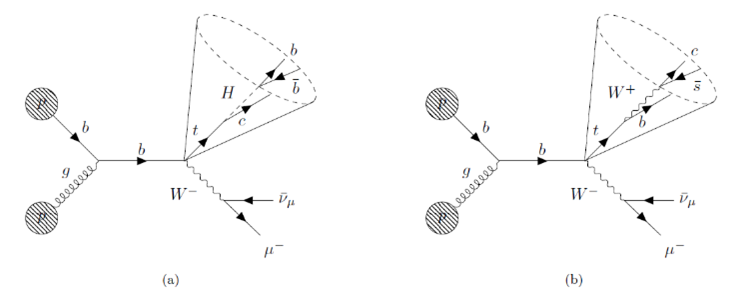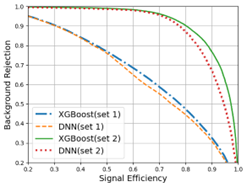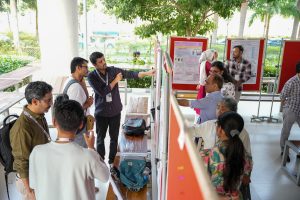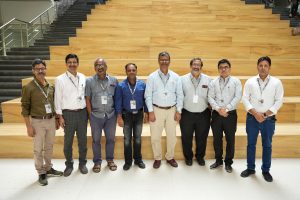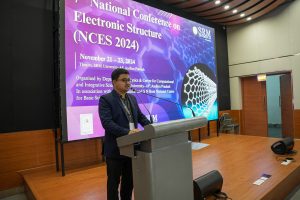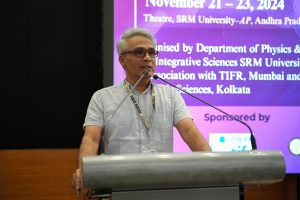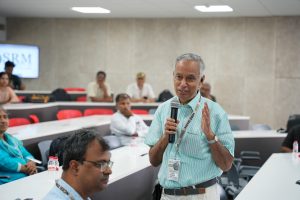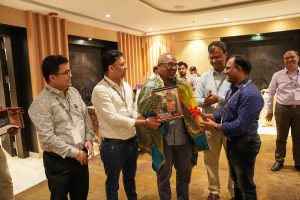Recent News
- Dr Amit Chakraborty and Scholar Publish their Research in Nature Index Journal March 21, 2025
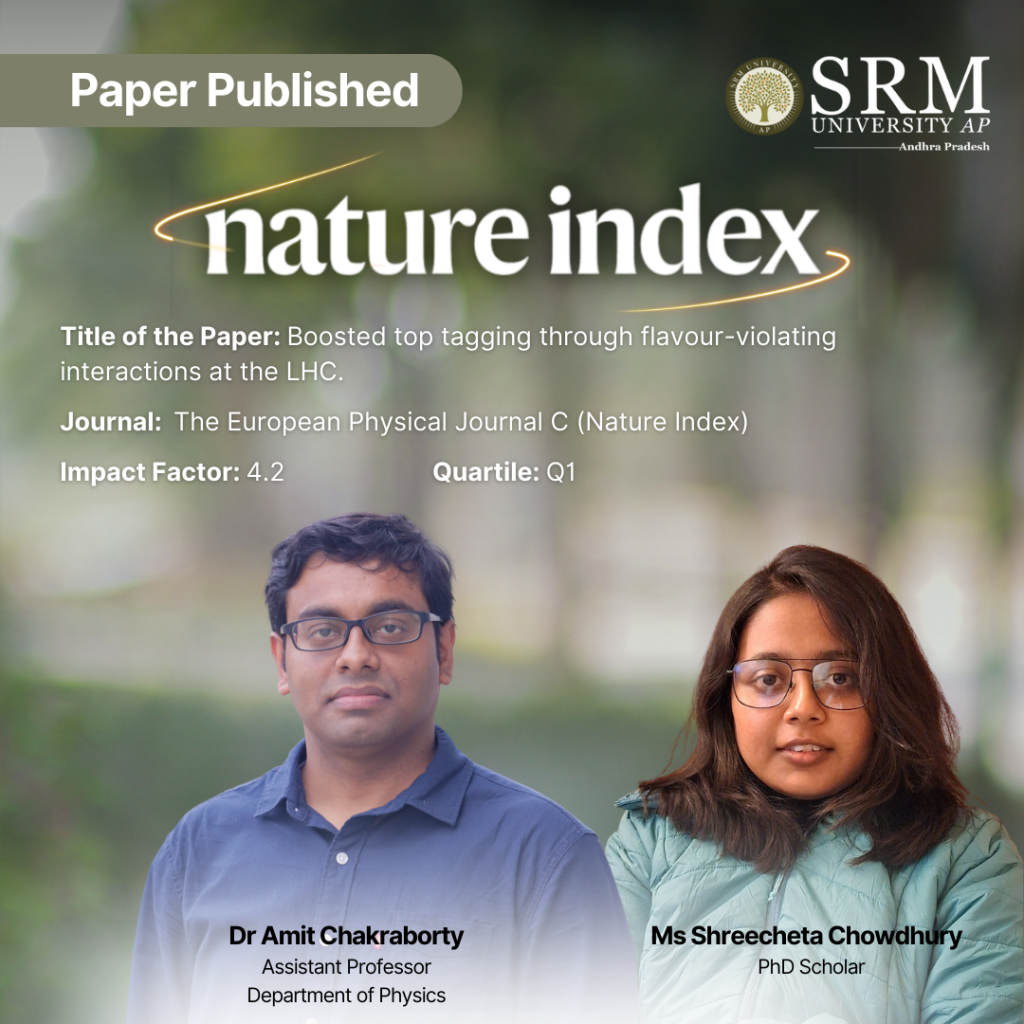
Dr Amit Chakraborty, Assistant Professor in the Department of Physics and Ms Shreecheta Chowdhury, PhD Scholar, have co-authored a research paper titled “Boosted top tagging through flavour-violating interactions at the LHC”, which has been published in the European Physical Journal C (Nature Index), Q1 Journal having an impact factor 4.2.
Their research focuses on identifying a rare process involving the top quark, one of the heaviest particles. In this rare decay, the top quark transforms into a charm quark and a Higgs boson, which then breaks down into two b quarks. The team uses the data collected at the Large Hadron Collider (LHC), the world’s largest particle smasher, and employs Machine Learning techniques to investigate the possibility of understanding these collision events and identifying signatures of physics Beyond the Standard Model.
Abstract
This paper describes a method for detecting a rare top quark decay into a charm quark and a Higgs boson (H), which decays further into b quarks, at the Large Hadron Collider (LHC), and introduces a tagging algorithm to identify boosted tops using large-R jets containing b- and c-tagged elements. We consider the associated production of the top quark with a W-boson and identify different observables to discriminate the signal from the Standard Model (SM) background events. Although our model with improved jet substructure methods outperforms existing approaches to tag such rare decay tops, the improvement in the New Physics reach in terms of t → cH branching ratio is marginal, even at the high luminosity run of LHC, compared to the existing limits from the LHC 13 TeV data. Additionally, the paper utilizes SHAP, a Game Theory-based method, to analyse the contribution of each observable to the classification of events, offering valuable insights into the classifier.
Future Research Plans
The team plans to explore Beyond Standard Model (BSM) physics through collider phenomenology. Leveraging the Higgs boson as a portal, they aim to investigate its potential role in dark matter interactions, neutrino mass generation, and possibly being part of a larger scalar sector. Additionally, Dr Chakraborty will delve into ultra-light particle searches and develop novel jet physics techniques using advanced Machine Learning (ML) algorithms for particle identification and classification. A crucial aspect of his work will be creating testable search strategies, ensuring direct comparison with experimental data from current and future colliders.
Continue reading → - Theory-Experiment Dialogue on Big Bang Nucleosynthesis February 14, 2025

The Department of Physics organised a Department Research Seminar on February 05, 2025, that offered a theoretical expression on Big Bang Nucleosynthesis. The seminar, which unravelled as a theory-experiment dialogue, also delved into interesting topics like Quantum Field Theory and General Relativity. Dr Martin Schaefer, nuclear physicist from the Department of Theoretical Physics Nuclear Physics Institute, Czech Academy of Sciences was the keynote speaker of the session.
The key idea of this session was to understand the means of the Big Bang and the Standard Model Lagrangian Method. Dr Schaefer discussed the nuclear reactions that formed the early universe and had an interaction session with the participating students and scholars.
The workshop was based on ‘Big Bang to Now: Exploring the Origins of the Universe’ with Nuclear Processes during Big Bang Nucleosynthesis. It focused on understanding the universe’s origins and the nuclear processes responsible for its birth during Big Bang nucleosynthesis.
Big Bang Nucleosynthesis (BBN) refers to the process that occurred roughly 10 seconds after the Big Bang when the temperature of the universe dropped enough for atomic nuclei to form. This has led to the creation of stable elements such as helium and lithium isotopes, which played a crucial role in the evolution of the universe. The specific abundance of these elements provides observable imprints in the universe today, helping scientists validate theories like the Hot Big Bang Model and the Standard Model of particle physics.
The study of BBN allows scientists to understand the fundamental forces and nuclear interactions that governed the early universe. Dr Martine Schaefer provided insightful and educative information by helping scientists test the hot Big Bang theory. The session proved to be an incredible platform for scholars, students, and faculty to collaborate and discuss theoretical and experimental physics.
Continue reading → - 3-Day Conference on “From Big Bang to Now” Concludes January 27, 2025
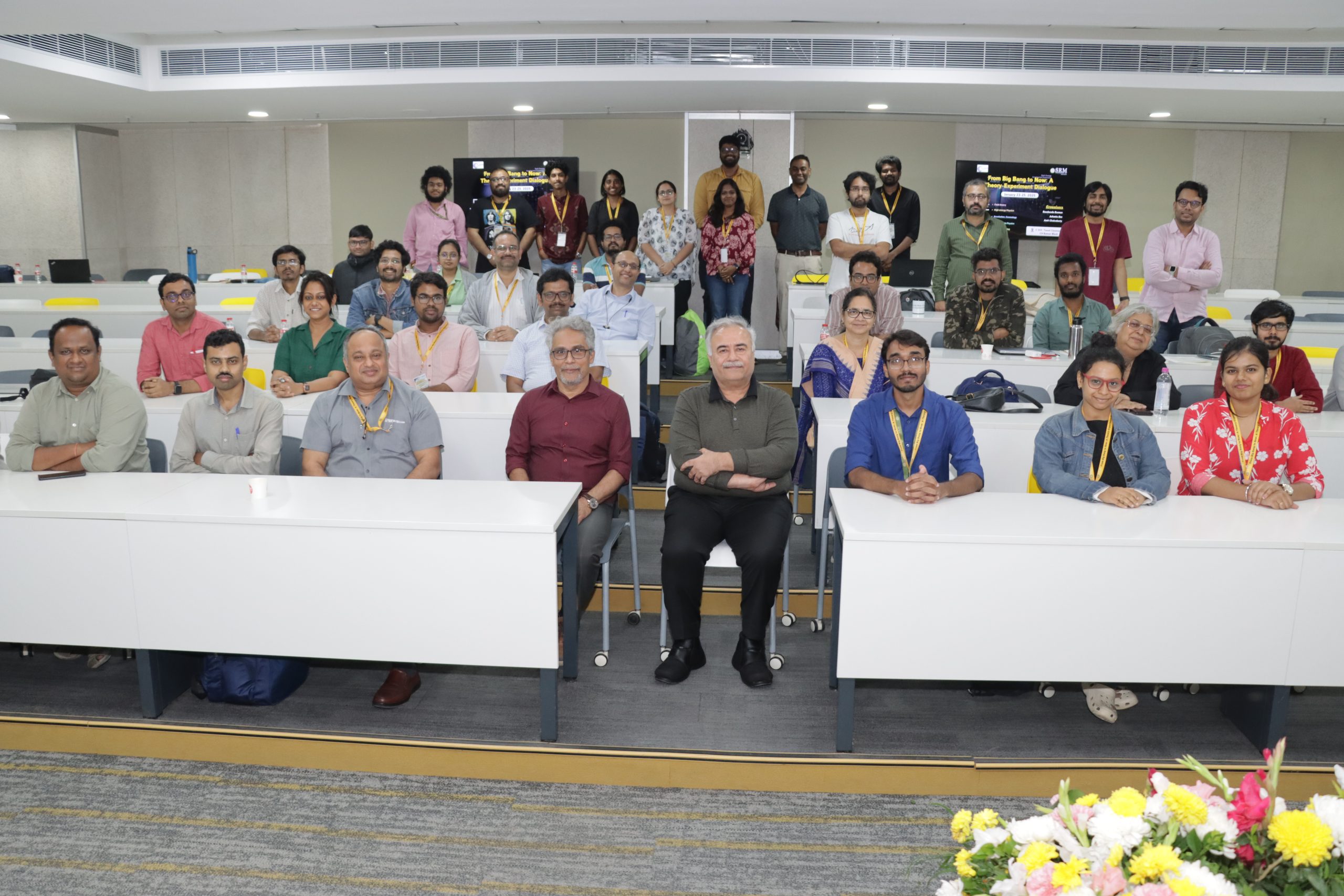 The Department of Physics organised a 3-day conference on “From Big Bang to Now : A Theory-Experiment Dialogue.” The event witnessed the presence of – Prof. Ranjit Thapa, Dean-Research; Dr C V Tomy, Dean-School of Engineering and Sciences, Dr Pranab Mandal, Head – Department of Physics, Prof. Sreerup Raychaudhuri along with Assistant Professors Dr Ashmita Das, Dr Basabendu Barman and Dr Amit Chakraborty.
The Department of Physics organised a 3-day conference on “From Big Bang to Now : A Theory-Experiment Dialogue.” The event witnessed the presence of – Prof. Ranjit Thapa, Dean-Research; Dr C V Tomy, Dean-School of Engineering and Sciences, Dr Pranab Mandal, Head – Department of Physics, Prof. Sreerup Raychaudhuri along with Assistant Professors Dr Ashmita Das, Dr Basabendu Barman and Dr Amit Chakraborty.As part of the inaugural address Dr C V Tomy highlighted the varsity’s prowess in terms of its accomplishments for a relatively young University, he stated that the varsity’s H-index of 59 reflects its significant global impact, the department of physics has also been the FIST sponsored Department among many other departments in the university.
Prof. Ranjith Thapa in his address stated, “SRM University-AP is a self-reliant institution, generating its own resources to fund cutting-edge research and education,” he also welcomed students to be a part of the academic community at SRM AP.
The Department head, Dr Pranab Mondal stated, “Since the inception we have grown tremendously as a department and as a university, both in terms of academic output and research impact. We also focus on actively collaborating with other departments to focus on not just research but also on advancing higher education and have strived to make the department what it is today.”
Prof. Sreerup Rayachaudhuri, visiting professor at the varsity and former professor at the TIRF said, “There are 4 categories of universities in India, the IITs, the private universities, the government universities and research institutes. Although SRM AP is a private university, it strongly encourages research, the very existence of this conference today, exemplifies the varsity’s commitment to fostering research culture.”
The conference also featured engaging presentations and lectures by students and faculty from various prestigious institutions across India. The event served as a platform for knowledge exchange, and networking, further strengthening SRM University-AP’s reputation as a hub for academic and research excellence.
The 3-day conference concluded with a renewed commitment to spreading knowledge in the field theory, high-energy physics, Astroparticle physics and Machine Learning, ensuring that SRM University-AP continues to contribute significantly to global scientific progress.
Continue reading → - ETOT 2024 : Advancing Optical Technology in India January 9, 2025
The Department of Physics organised the International Conference on Emerging Trends in Optical Technology (ETOT 2024), showcasing the latest advancements in the field of Optical Technology. The conference featured esteemed chairpersons Prof. R P Singh and Prof. Achanta Venugopal, alongside distinguished dignitaries including Registrar, Dr R Premkumar, Dean-SEAS , Prof. C V Tomy, and Dean-Research, Prof. Ranjit Thapa.
In his inaugural address, Dr Gangi Reddy Salla, Associate Professor and programme convenor from the Department of Physics, emphasised the vital role of Optical Technology in contemporary society. He stated, “This conference serves as a crucial platform for discussing the emerging trends and innovations in Optical Technology, reflecting its significance in various sectors today.”
The conference hosted 62 distinguished speakers from India and abroad, receiving a total of 103 abstracts, with 40 contributions from the university across various departments. As an association with IOP Proceedings, special acknowledgment will be featured in its upcoming issue. Additionally, the conference was generously supported by sponsors exceeding 10 lakhs, including notable companies such as ANRF, ATOS, Advanced Photonics,AIMIL and CIPHR and the University of Tartu. OPTICA also endorsed this significant event.
During the proceedings, five exemplary paper awards were announced in honour of the conference chairperson Prof. R P Singh. In his welcome address, Prof. C V Tomy remarked, “Despite being only seven years old, the university has made significant strides in research, this conference is testimonial to the varsity’s research excellence and will not just pave way for advancements in the field of optical technology, but will also fosters collaboration between industry leaders and academic experts.”
Prof. Achanta Venugopal highlighted the pressing need for a uniform curriculum in Optics and Photonics nationwide. He expressed concern over the lack of fabrication laboratories to expand research possibilities, saying, “Conferences like these can significantly impact our field by addressing the necessity for such facilities, prompting governmental action to support our academic aspirations.”
Prof. R P Singh urged attendees to broaden their research applications beyond academic papers, particularly in fields such as Agriculture and Medicine. He stated, “The utilisation of optical technologies can revolutionise these sectors, and it is essential for our research to resonate with real-world challenges and reach those in need.”
The event concluded with the recognition of the chairpersons by Registrar Dr R Premkumar, Dean-SEAS, Prof. C V Tomy, and Dean-Research, Prof. Ranjit Thapa. The release of the abstract book marked another highlight of the conference, with Dr Ravi Kumar delivering the vote of thanks. The event also featured insightful presentations and discussions from prominent speakers representing renowned institutions both in India and internationally.
Continue reading → - SRM AP Hosted the 7th National Conference on Electronic Structure December 3, 2024
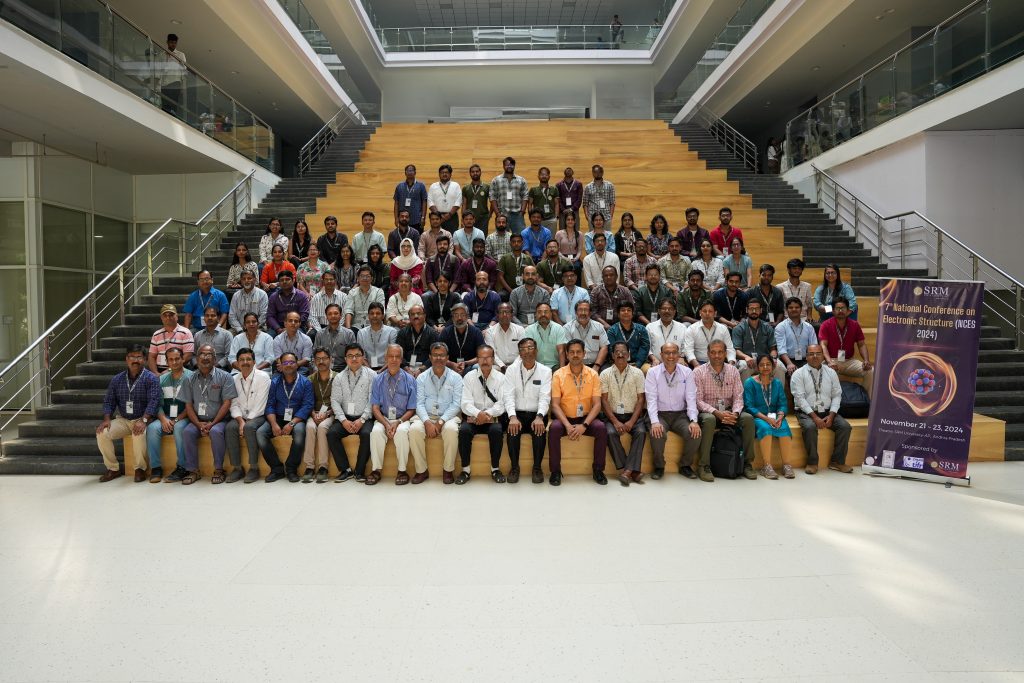
The 7th National Conference on Electronic Structure successfully concluded at SRM University-AP on November 21 – 23, 2024, under the aegis of the Department of Physics and the Centre for Computational and Integrative Sciences. The conference provided a dynamic platform for discussions and interactions on the recent advances in electron spectroscopy, microscopy, and related theoretical approaches to understanding the electronic structure of materials.
NCES was also aimed at capacity building in the field of electronic structure. Scientists, researchers, and scholars from universities and research institutes assembled to delve deep into research on electronic structure-related projects and works. Scientific discussions and invited lectures showcased insightful sessions by domain experts from India.
Out of forty poster participants, four poster winners were awarded a certificate of appreciation and Rs.3000/—each in recognition of their effort and dedication, contributing to their success.
Prof. Ranjit Thapa (Convenor), Prof. Kalobaran Maiti (National Convenor), and Prof. B R Sekhar (National Convenor) spoke about the significance of the event, which helped scholars know the importance of the NCES event in terms of fruitful scientific interactions and collaborations with each other.
The participants were also on a short tour around Undavalli caves and Kanak Durga Temple. The tour plan facilitated an informal platform for participants to communicate freely and network with others for long-term collaborations.
The 7th National Conference on Electronic Structure was an inspiring experience for all participants, encouraging research scholars to work in the field of electronic structure. The conference also facilitated a conducive environment for problem-solving and innovation.
Continue reading →


